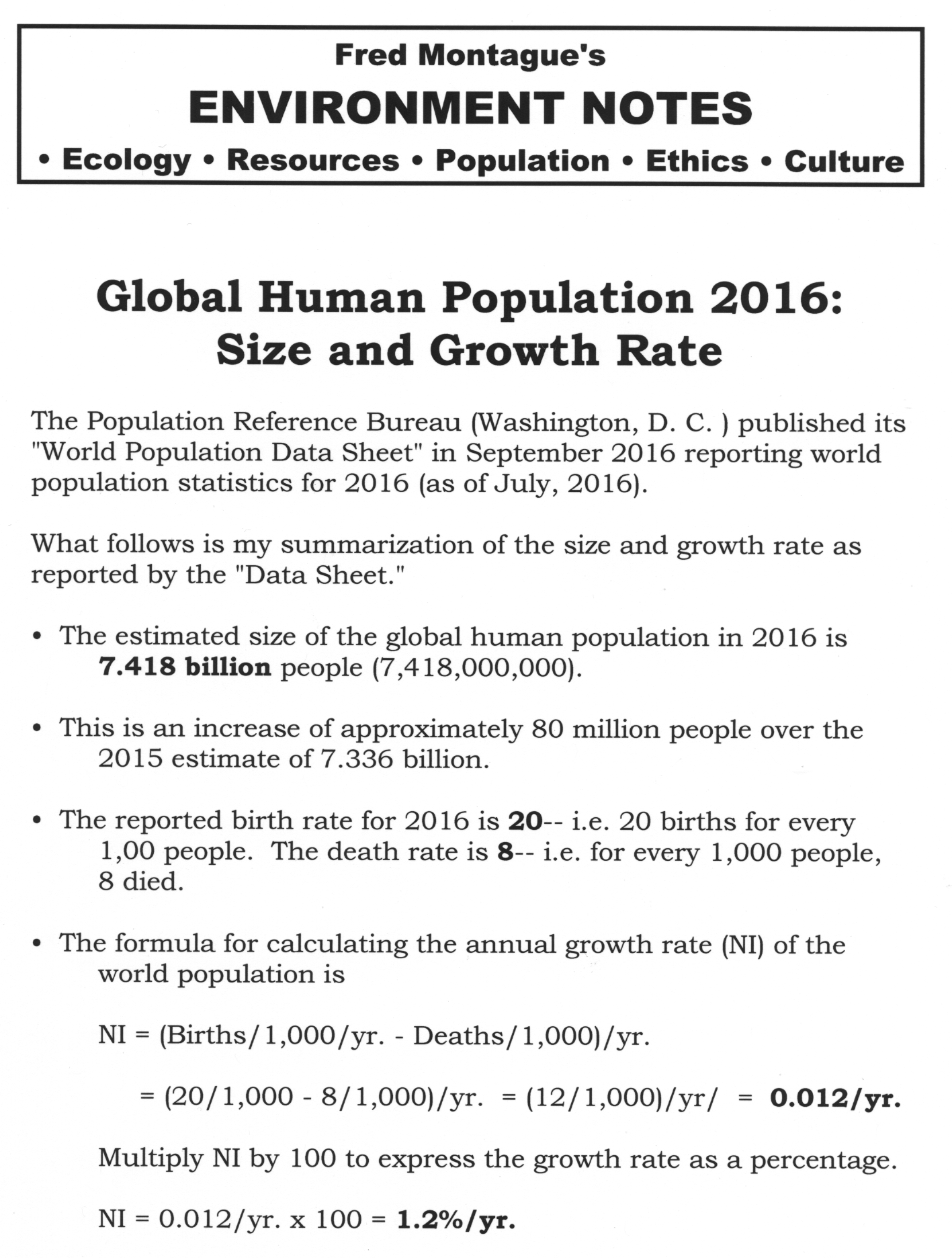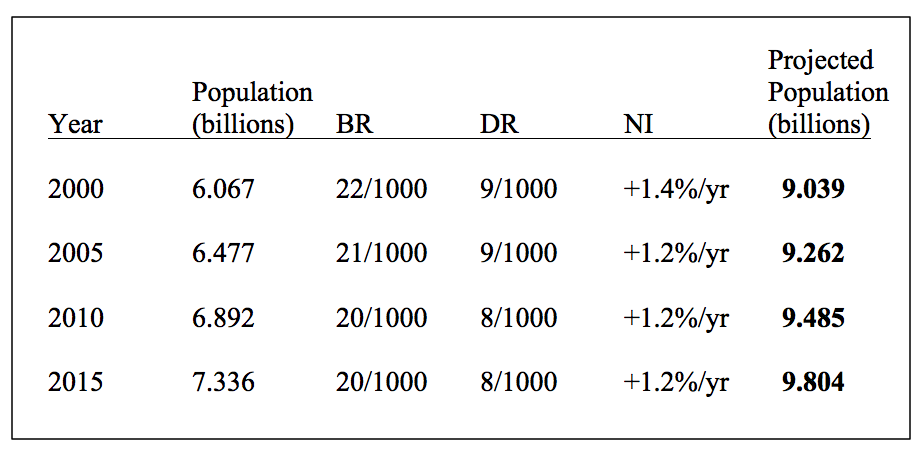This weekly blog post and its host website cover a wide variety of Fred Montague's environmental commentaries, gardening topics, and wildlife/art activities. Please browse the website and the blog archives for topics you are interested in.
This Week's Post: Global Human Population 2016: Size and Growth Rate
This weekly blog post and its host website cover a wide variety of Fred Montague's environmental commentaries, gardening topics, and wildlife/art activities. Please browse the website and the blog archives for topics you are interested in.
This week's post: 2050 Global Human Population Revised Upward--Again
This weekly blog post and its host website cover a wide variety of Fred Montague's environmental commentaries, gardening topics, and wildlife/art activities. Please browse the website and the blog archives for topics you are interested in.
2050 Global Human Population Revised Upward--Again
Each year at this time I view the Population Reference Bureau's annual "World Population Data Sheet."
Of particular interest to me is the trend over the past 15 years or more to increase the Bureau's projection for the size of the human population in 2050.
To keep things simple, the following table from the "Data Sheets" shows the projections for 2000, 2005, 2010, and 2015, in addition to four other important demographic statistics. (The intervening years fit the trend.)
Table Notes:
BR = birth rate (# of births per 1,000 people).
DR = death rate (# of deaths per 1,000 people).
NI = natural increase (growth rate of the population).
The just-published "2016 Data Sheet" projects the 2050 population to be 9.869 billion.
The PRB states: "the projected populations [are] based on reasonable assumptions of the course of fertility, mortality, and migration [relevant only for individual country projections]. Projections are based on official country projections, series issued by the U.N. or the U.S. Census Bureau or PRB publications.
Since 2000, these projections have been updated to show the potential addition of about 0.83 billion more people than the 2000 projection of 9 billion. If these projections are accurate, by 2050 there will be 2.4 billion more humans than today. This total population increase of nearly 32% will occur in the next 34 years.
Future posts will address some of the challenges and opportunities this unprecedented population phenomenon offers.
This Week's Post: Another View of Global Population Increase
This weekly blog post and its host website cover a wide variety of Fred Montague's environmental commentaries, gardening topics, and wildlife/art activities and shop. Please browse the website and the blog archives for topics you are interested in.
This Foxsense II page calls our attention to the fact that in 14 years we will add more than a billion people to the human population. With humans using 48% of the Earth's land surface to feed a single species (us), what will be the prospects for the other 2 to 10 million species on the planet?
Not only will it be a challenge to feed humans, but at the current rate that industrial agriculture diminishes soil, water, and crop biodiversity, we will also be crowding out other species, natural areas, and the critical ecological functions they provide to support all kinds of life on Earth.
Fox Sense II, a new work in the Fox Sense series, is scheduled to be released later in 2016. Each volume in the series consists of a hand-bound collection of environmental mini-posters written and illustrated by Fred and accompanied by the insightful (and sometimes cynical) commentary of a watchful fox. These volumes make excellent reading for anyone concerned about the currently trajectory of human impacts on the Earth. The 24th Anniversary Edition of Fred's 1992 classic collection, Fox Sense I, is currently available.
Temporary Food
Modern, corporate-based industrial agriculture has many critics. They range from scientists to some politicians, from citizens to some farmers. Their main concern is that the very tenets that make the operation feasible from the agribusiness point-of-view create conditions that undermine its long-term prospects. These tenets include 1) corporate efficiency (standardization, economy of scale, large cropping units, fewer farmers, more machines, etc.), 2) maximization of production and profit (intensification, fertilizers, pesticides, irrigation, etc.), and 3) corporate control of farm inputs (proprietary seeds, genetically modified crop plants, mandatory customized packages of agrichemical inputs, etc.).
Some of the serious problems that arise from this approach to farming include soil erosion, water pollution, groundwater depletion, freshwater diversions, loss of crop plant diversity, depletion of fossil fuels, loss of local farming knowledge, carbon emissions, loss of natural habitats, and loss of biological diversity. Please refer to the introduction in my book, Gardening: An Ecological Approach. (especially page 13).
Humanity faces many challenges. The “environmental fact sheet” below is offered to provide a sense of perspective about how the current human population of more than seven billion people is seven hundred times the size that could be supported without modern agriculture’s ruthless, profit-driven assault on the planet.
By the late 2050s, about 43 years from now, some demographers estimate a human population of ten billion, more than a thousand times the size that Nature could have sustainably supported.
What to do: Learn about the issues. Share what you know. Rethink the ways we grow our food and reform agriculture. Support small sustainable farms. Get to know one local grower. Protect environmental quality. Restore degraded land. Conserve critical resources. Grow a garden. Share what you grow.
Environmental Science Classroom: Human Population V
Most Populous Countries
The population fact sheet reproduced below shows the world's 17 most populous countries as compiled from the Population Reference Bureaus' "2012 World Population Data Sheet."
I arbitrarily selected all the countries in the world with populations of more than 75 million citizens.
The most rapidly growing of these large countries are all U.N. "developing countries" with gross national income/capita and rates of population increase greater than the world average.
"Human Population V" © Fred Montague.
Environmental Science Classroom: Human Population IV
Region-By-Region
The page shown below was a perennial assignment in my Global Environmental Issues classes. Students were asked to use the Population Reference Bureau's current "World Population Data Sheet" and complete the demographic characteristics for each of the world's continents/regions. I have filled them in for you.
It is only part of the population picture to know, as we have shown in the past three population blog posts, the the human population is increasing.
Because of a quirk of geography and rate of development, population growth is uneven.
Here are the questions I asked with respect to this assignment.
Which continent/region...
... is the most populous?
... has a stable population (currently not increasing nor decreasing)?
... is the youngest (i.e. has the greatest potential for future population growth)?
... has the highest NI (rate of increase)?
... has the shortest population doubling time if current birth and death rates continue?
... has the highest TFR (total fertility rate or average number of children per woman)?
Note: The data in the tables are as of mid-year 2012. Russia is part of Europe. Immigration and Emigration are not considered.
The geography of human population growth. © Fred Montague
Environmental Science Classroom: The Human Population II
The notebook page shown below depicts the growth, billion-by-billion, of the human population. From the earliest traces of Homo sapiens in the anthropological record, it took 150,000 to 200,000 years for the population to grow to one billion (in 1800).
The table shows the year that the population added each billion and the number of years it took to do so. The peak growth rate seems to have occurred during the last 35 years. This is where the slope of the graph is the steepest and where the intervals to add a billion people are the shortest.
Demographers (including the UN) predict the population will grow to 9.6 billion by 2050 and perhaps 10-11 billion by 2100.
No one, except a few wildlife biologists, are predicting that the population will "level off" in the near future. Wildlife biologists are thinking that in the next 37 years we will add another 2.5 billion people, 35% more than now, but we are not likely to increase the productive surface of the Earth by 35% to provide them with the resources (on a per-capita basis) that the 7.1 billion current residents of the planet have. Wildlife biologists often use a term called "carrying capacity."
The growth of the Earth's human population truly defines our times.
Refer to the blog on Wednesday, February 13, 2013 for "The Human Population I" (Current Size and Growth Rate).
Environmental Science Classroom: "The Human Population I"
The population fact sheet shown below outlines the calculation of the current (2012) growth rate of the global human population.
This is the first in a series intended to illuminate various characteristics of the "people phenomenon."










